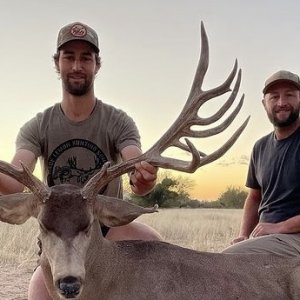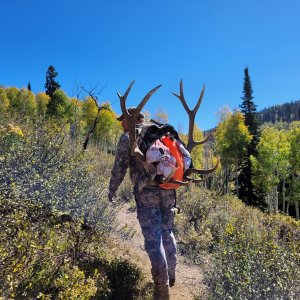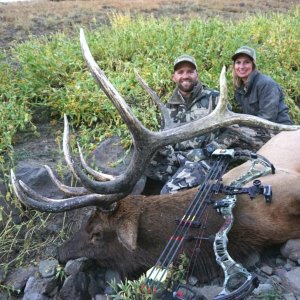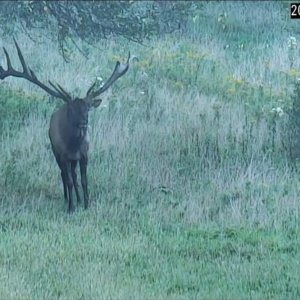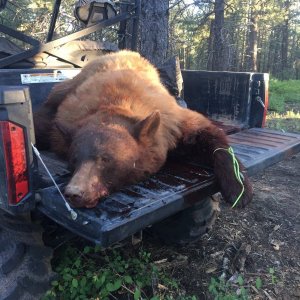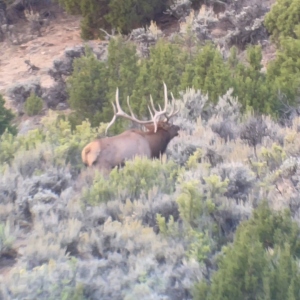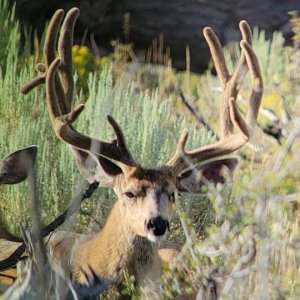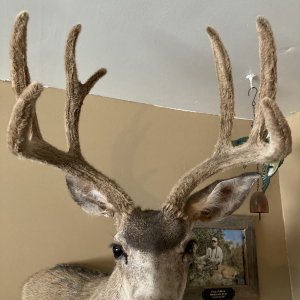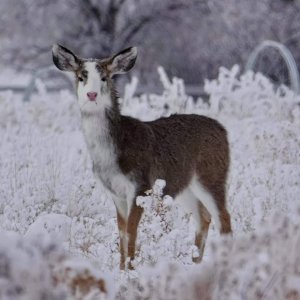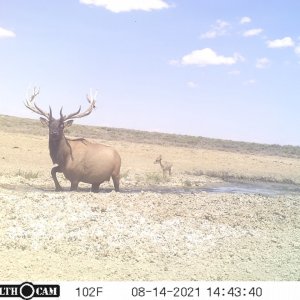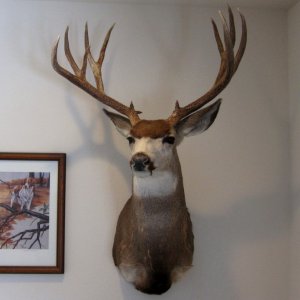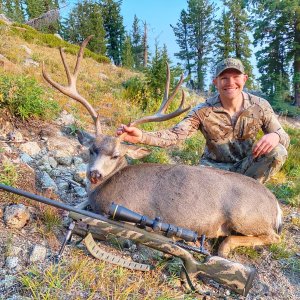SMOKESTICK
Active Member
- Messages
- 852
Does anyone believe that the USFWS has gone too far with how they are treating elk on the National Elk Refuge?
Perhaps some may be unaware of the situation so I am posting an article from Wyoming Game & Fish Commissioner Clark Allan from Teton County.
Starvation on the Refuge
While exact numbers will never be known, State Game & Fish biologists estimate that 25% or more of the calf elk on the National Elk Refuge died this last winter. By comparison, 3% of elk calves were lost on State run feed grounds.
In the first week of February it became obvious to local Game & Fish personnel that the refuge elk were in trouble, however their concerns did not carry weight with refuge managers. Concerned over the situation, State officials transported about 20 elk, (mostly calves), to the Wyoming State Veterinarian?s office where it was determined about half had been starved to death outright. The other half died of a combination of malnutrition and a starvation driven foot disease. Because of malnutrition these calves had been forced to dig for feed under the hard crusted snow causing damage to their feet and permitting the disease to take hold.
When official elk counts were conducted on the refuge it was discovered that refuge officials had underestimated the number of elk by about 2,000. Rations were also short because refuge managers failed to recognize the need to feed more per elk when natural feeds are locked under snow and ice, as they were this past winter. ?Supplemental? pellets become the entire diet under such conditions.
Although the refuge has not been surveyed for mortality, except in core feeding areas, refuge officials have estimated the calf elk mortality at 20%. That estimate is presumed low because, the refuge staff has been instructed not to document any more elk mortality. Aside from an attempt to avoid political exposure, it is hard to explain why refuge managers would not want complete scientific data on the situation. To make matters worse, State biologists believe elk mortality as a delayed result of starvation to be ongoing. In other words, many starving elk calves, while still on their feet, have passed the point of no return and will not recover despite the relief provided by spring.
At the heart of the problem is a basic difference in the objectives of State feed ground managers and their federal counterparts. While State managers try to keep elk off of private land, refuge managers endeavor to expel elk from the feed lines. Thus, elk on the refuge tend to be fed later and less than elk on State feed grounds.
It is important to note here the fallacy of the notion that you can move elk off of the refuge by keeping their rations below the level needed to sustain them. In spite of last winter?s dire conditions, the elk did not leave the refuge for the vast natural winter ranges fantasized about by opponents of elk feeding. These natural wintering areas simply do not exist. They have been removed by human development. Furthermore, adult elk do not leave because they generally get enough feed to sustain them by consuming both their own short rations and those intended for the calves. Thus, we see why most of the starved elk are calves.
Additionally, to the extent that natural winter ranges do exist, moose, deer and bighorn sheep already occupy these limited ranges. Putting thousands of elk out on them will only harm other important species. Nevertheless, the refuge managers are not charged with managing wildlife outside refuge boundaries and appear deaf to broader State concerns.
Is it possible that some of the mismanagement on the refuge is intentional? Contrary to the dictates of responsible management, current feeding practices on the refuge appear to be focused on providing optimal conditions for disease transmission. Elk that are weakened from lack of nutrition and bunched together into large groups are exceptionally vulnerable to disease outbreak. On the other hand, elk that are healthy and that are spread out over a relatively large area in numerous small groups are resistant to the spread of disease. In fact, if done right, elk on feed may be more disease resistant than elk on winter-range. In contrast, I have been told that the goal of refuge managers is to maintain elk in a ?catatonic? state, or a state of semi-starvation where they lose considerable muscle mass, but still survive until spring. Additionally, it was apparent this year that the elk were crowded together primarily in two large dense groups.
The anti-feed ground groups? primary attack on elk feeding programs is the potential for disease transmission among concentrated elk. It would seem that the refuge managers have done everything within their power to facilitate the calamity prophesied by the anti-feeders. On the other hand refuge managers have the ability and opportunity to manage in a manner that would minimize the chance of a disease epidemic. Only a small percentage of the refuge is currently used for feeding. In spite of ample opportunity to do things right, managers have simply chosen unhealthy practices over sound ones.
Finally, just a word on the ?anti-predator? label so gratuitously tossed into the debate by the News & Guide. I believe in active management of game numbers. This includes deer and elk as well as various predators classified as trophy game. Reducing deer numbers to stay within winter range capacity does not make a person ?anti-deer?. By the same token management of mountain lion numbers to stay within the capacity of game herds to sustain them does not make a person ?anti-lion? or ?anti-predator?.
Perhaps some may be unaware of the situation so I am posting an article from Wyoming Game & Fish Commissioner Clark Allan from Teton County.
Starvation on the Refuge
While exact numbers will never be known, State Game & Fish biologists estimate that 25% or more of the calf elk on the National Elk Refuge died this last winter. By comparison, 3% of elk calves were lost on State run feed grounds.
In the first week of February it became obvious to local Game & Fish personnel that the refuge elk were in trouble, however their concerns did not carry weight with refuge managers. Concerned over the situation, State officials transported about 20 elk, (mostly calves), to the Wyoming State Veterinarian?s office where it was determined about half had been starved to death outright. The other half died of a combination of malnutrition and a starvation driven foot disease. Because of malnutrition these calves had been forced to dig for feed under the hard crusted snow causing damage to their feet and permitting the disease to take hold.
When official elk counts were conducted on the refuge it was discovered that refuge officials had underestimated the number of elk by about 2,000. Rations were also short because refuge managers failed to recognize the need to feed more per elk when natural feeds are locked under snow and ice, as they were this past winter. ?Supplemental? pellets become the entire diet under such conditions.
Although the refuge has not been surveyed for mortality, except in core feeding areas, refuge officials have estimated the calf elk mortality at 20%. That estimate is presumed low because, the refuge staff has been instructed not to document any more elk mortality. Aside from an attempt to avoid political exposure, it is hard to explain why refuge managers would not want complete scientific data on the situation. To make matters worse, State biologists believe elk mortality as a delayed result of starvation to be ongoing. In other words, many starving elk calves, while still on their feet, have passed the point of no return and will not recover despite the relief provided by spring.
At the heart of the problem is a basic difference in the objectives of State feed ground managers and their federal counterparts. While State managers try to keep elk off of private land, refuge managers endeavor to expel elk from the feed lines. Thus, elk on the refuge tend to be fed later and less than elk on State feed grounds.
It is important to note here the fallacy of the notion that you can move elk off of the refuge by keeping their rations below the level needed to sustain them. In spite of last winter?s dire conditions, the elk did not leave the refuge for the vast natural winter ranges fantasized about by opponents of elk feeding. These natural wintering areas simply do not exist. They have been removed by human development. Furthermore, adult elk do not leave because they generally get enough feed to sustain them by consuming both their own short rations and those intended for the calves. Thus, we see why most of the starved elk are calves.
Additionally, to the extent that natural winter ranges do exist, moose, deer and bighorn sheep already occupy these limited ranges. Putting thousands of elk out on them will only harm other important species. Nevertheless, the refuge managers are not charged with managing wildlife outside refuge boundaries and appear deaf to broader State concerns.
Is it possible that some of the mismanagement on the refuge is intentional? Contrary to the dictates of responsible management, current feeding practices on the refuge appear to be focused on providing optimal conditions for disease transmission. Elk that are weakened from lack of nutrition and bunched together into large groups are exceptionally vulnerable to disease outbreak. On the other hand, elk that are healthy and that are spread out over a relatively large area in numerous small groups are resistant to the spread of disease. In fact, if done right, elk on feed may be more disease resistant than elk on winter-range. In contrast, I have been told that the goal of refuge managers is to maintain elk in a ?catatonic? state, or a state of semi-starvation where they lose considerable muscle mass, but still survive until spring. Additionally, it was apparent this year that the elk were crowded together primarily in two large dense groups.
The anti-feed ground groups? primary attack on elk feeding programs is the potential for disease transmission among concentrated elk. It would seem that the refuge managers have done everything within their power to facilitate the calamity prophesied by the anti-feeders. On the other hand refuge managers have the ability and opportunity to manage in a manner that would minimize the chance of a disease epidemic. Only a small percentage of the refuge is currently used for feeding. In spite of ample opportunity to do things right, managers have simply chosen unhealthy practices over sound ones.
Finally, just a word on the ?anti-predator? label so gratuitously tossed into the debate by the News & Guide. I believe in active management of game numbers. This includes deer and elk as well as various predators classified as trophy game. Reducing deer numbers to stay within winter range capacity does not make a person ?anti-deer?. By the same token management of mountain lion numbers to stay within the capacity of game herds to sustain them does not make a person ?anti-lion? or ?anti-predator?.

